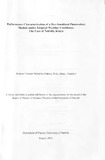Performance chacterization of a dye-sensitized photovoltaic module under tropical weather conditions: the case of Nairobi, Kenya

View/
Date
2012Author
Otakwa, Raphael Venson Makokha
Type
ThesisLanguage
en_USMetadata
Show full item recordAbstract
The performance of a Dye-sensitized solar module (DSSM) of active area 175.12 cm has been investigated at a tropical climate area at co-ordinates 35.81 ᄚ East, 1.280 South. Investigation of the DSSM's performance parameters; short circuit current density (.Ise), open circuit voltage (Voe), fill factor (FF) and solar-to-electricity conversion efficiency (rf) has been carried out under different values of air mass (AM), irradiance intensities, and the DSSM's surface temperature.
As AM increased from 1 to 1.09, Voe reduced linearly by 2.05% from 8.31 V to 8.14 V. J,,'c also reduced linearly but by 26.06%, from 1.04xlO-3 Acm' to 7.69xlO-4 Acm', FF increased linearly by 19.05% from 0.51 to 0.63, while 11 increased by 27.68% from 1.77% to 2.26% as AM increased from 1 to 1.04, and then reduced to 1.27% at AMI.05, followed by an increase of 1.06% at AM 1.08 before increasing to 1.19% at AM 1.09. The good response of the DSSM to short wavelength radiation made it perform well at increased AM values as compared to what is reported of Amorphous Silicon (a-Si) photovoltaic (PV) devices.
As irradiance intensity increased from 653 Wm-2 to 805 Wm-2, Voe increased linearly by 11.94% from 7.12 V to 8.07 V . .Ise also increased linearly, but by 64.41% from 5.92xlO-4 Acm' to 9.66xlO-4 Acm-2 as irradiance intensity increased from 653 Wm-2 to 997 Wm-2ユ FF decreased linearly by 20.55% from 0.73 to 0.58 as irradiance intensity increased from 653 Wm-2 to 1095.7 Wm-2, while IJ increased linearly by 5.74% from 4.70% to 4.90% as irradiance intensity increased from 653 Wm-2 to 747 Wm-2ユ
The DSSM performed better compared to what is reported of a-Si PV devices under irradiancedependence. From temperature-dependence studies, Voe decreased linearly by 41.22% from 9.80 V to 5.76 V as the DSSM's surface temperature increased from 31.6ᄚC to 43.8ᄚC. .!se also decreased linearly but by 3.26% from 7.98xlO-4 Acm-2 to 7.92xlO-4 Acm-2 while FF and IJ linearly increased and decreased by 14.04% from 0.57 to 0.65 and by 33.50 % from 5.95 % to 3.95 % respectively as the DSSM's surface temperature increased from 31.6ᄚC to 43.8ᄚC.
Better performance for the DSSM was observed compared to what is reported of a-Si PV devices. The DSSM's overall performance was found to be better than what is reported of a-Si PV devices under the limiting conditions of AM, irradiance intensity and device surface temperature. The results are useful in respect of PV sizing, especially in the area of Building Integrated Photovoltaics (BIPV) in Kenya and the tropics.
Publisher
University of Nairobi, Kenya
